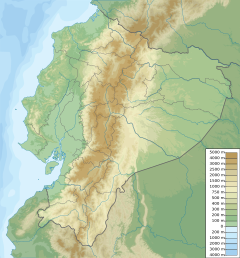Atelopus onorei facts for kids
Atelopus onorei is a small, brightly colored toad species. It belongs to the family Bufonidae, which includes many types of toads. This special frog is only found in Ecuador, in a specific area called the Azuay Province. Sadly, it has not been seen since 1990. Scientists worry it might be extinct, but they hope some hidden groups might still exist.
Quick facts for kids Atelopus onorei |
|
|---|---|
| Conservation status | |
| Scientific classification | |
| Atelopus onorei is only known from its type locality in the Azuay Province. |
Contents
Meet Onore's Harlequin Frog
This unique frog is also known as Onore's harlequin frog. It was named after Giovanni Onore. He was an Italian missionary priest and an entomologist, which means he studied insects. Giovanni Onore also collected many amphibians, helping scientists learn more about them.
What Does It Look Like?
Onore's harlequin frog is quite small. Adult males are about 34 to 42 millimeters (1.3 to 1.7 inches) long. Females are a bit bigger, measuring about 42 to 48 millimeters (1.7 to 1.9 inches).
Its body is often a mix of bright orange-yellow and green colors. Sometimes, it can be a pale yellowish-brown with dark spots. A very cool feature is its eyes. The iris (the colored part of the eye) is a beautiful aqua blue. It has tiny black lines and a thin bluish-white stripe near the pupil. This frog does not have an eardrum that you can see. Its fingers do not have webbing, but its toes do.
Where Did It Live?
Atelopus onorei was last found in 1990. It lived in a cloud forest near the Río Chipla river. This area is about 2,500 meters (8,200 feet) above sea level. Scientists also found them near a small creek nearby. These frogs were active during the day. Many pairs were seen in amplexus, which is when frogs mate.
Why Did It Disappear?
Despite many searches, Atelopus onorei has not been seen since 1990. Scientists believe a serious frog disease called chytridiomycosis caused its disappearance. This disease is very dangerous for amphibians around the world.
Other dangers for this frog include trout fish, which might eat its tadpoles. Also, cattle grazing in its habitat could harm the areas where it lives. If any of these frogs are still alive, their numbers are likely very small.



